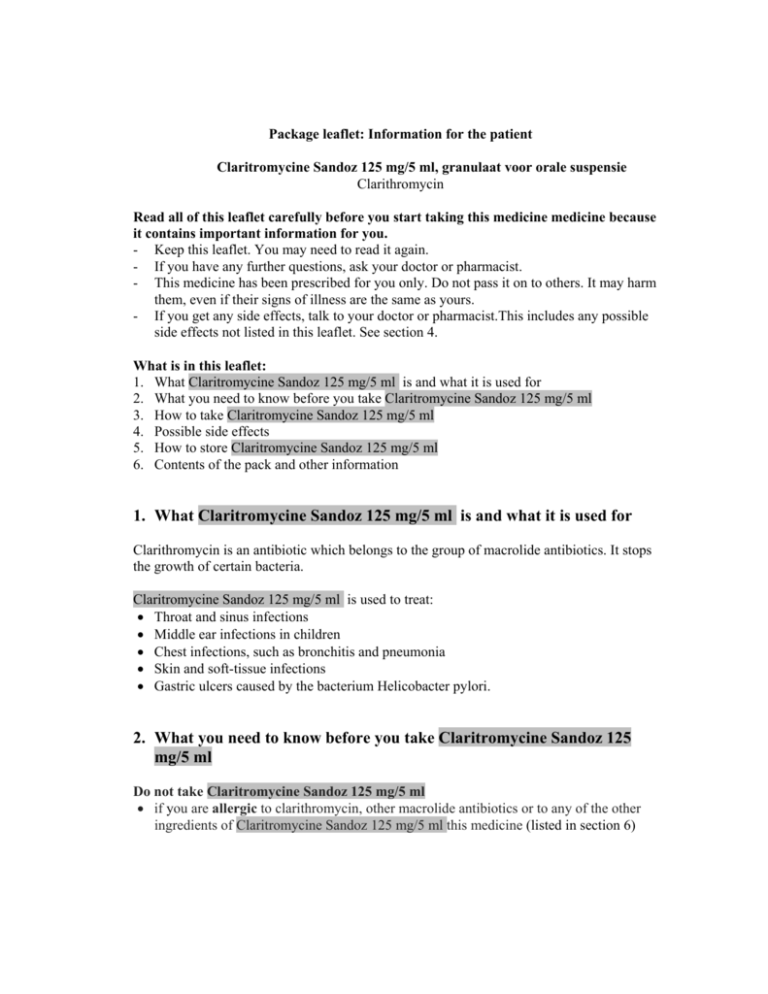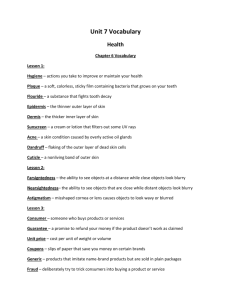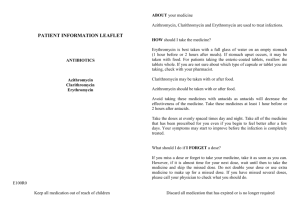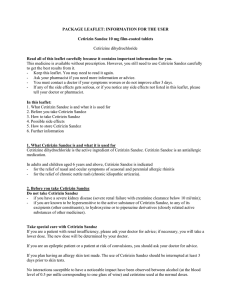1. What Claritromycine Sandoz 125 mg/5 ml is and what it is used for
advertisement

Package leaflet: Information for the patient Claritromycine Sandoz 125 mg/5 ml, granulaat voor orale suspensie Clarithromycin Read all of this leaflet carefully before you start taking this medicine medicine because it contains important information for you. - Keep this leaflet. You may need to read it again. - If you have any further questions, ask your doctor or pharmacist. - This medicine has been prescribed for you only. Do not pass it on to others. It may harm them, even if their signs of illness are the same as yours. - If you get any side effects, talk to your doctor or pharmacist.This includes any possible side effects not listed in this leaflet. See section 4. What is in this leaflet: 1. What Claritromycine Sandoz 125 mg/5 ml is and what it is used for 2. What you need to know before you take Claritromycine Sandoz 125 mg/5 ml 3. How to take Claritromycine Sandoz 125 mg/5 ml 4. Possible side effects 5. How to store Claritromycine Sandoz 125 mg/5 ml 6. Contents of the pack and other information 1. What Claritromycine Sandoz 125 mg/5 ml is and what it is used for Clarithromycin is an antibiotic which belongs to the group of macrolide antibiotics. It stops the growth of certain bacteria. Claritromycine Sandoz 125 mg/5 ml is used to treat: Throat and sinus infections Middle ear infections in children Chest infections, such as bronchitis and pneumonia Skin and soft-tissue infections Gastric ulcers caused by the bacterium Helicobacter pylori. 2. What you need to know before you take Claritromycine Sandoz 125 mg/5 ml Do not take Claritromycine Sandoz 125 mg/5 ml if you are allergic to clarithromycin, other macrolide antibiotics or to any of the other ingredients of Claritromycine Sandoz 125 mg/5 ml this medicine (listed in section 6) if you have a history of certain abnormal heart rhythms (ventricular arrhythmia, including torsades de pointes) or changes in the heart activity as measured in the electrocardiogram called “QT prolongation” if you suffer from severe liver failure and kidney problems at the same time if your blood potassium level is low if you are taking o ticagrelor (to prevent blood clotting) o ranolazine (used to treat angina pectoris) o ergotamine, dihydroergotamine (medicines to treat migraine), o cisapride (gastric medicine), o pimozide (antipsychotic), o terfenadine or o astemizole (antiallergics) o lovastatin, simvastatin (medicines to lower cholesterol) o colchicine (to treat gout) Claritromycine Sandoz 125 mg/5 ml Warnings and precautions Talk to your doctor or pharmacist before taking Claritromycine Sandoz 125 mg/5 ml if you have reduced liver or kidney function if you are allergic to lincomycin or clindamycin (antibiotics) if you develop severe or prolonged diarrhoea (pseudomembranous colitis) during or after taking Claritromycine Sandoz 125 mg/5 ml , consult your doctor immediately. Inflammation of the colon (Pseudomembranous colitis) has been reported with nearly all antibacterial medicines including clarithromycin. if you suffer from myasthenia gravis, a rare disease which causes muscle weakness if you have diabetes if you have, or have had, heart problems or if your magnesium level have previously been low if you have used clarithromycin before on several occasions or for a long time. Other medicines and Claritromycine Sandoz 125 mg/5 ml Tell your doctor or pharmacist if you are taking, or have recently taken, or might take any other medicines, including medicines obtained without a prescription. Certain other medicines may affect the effectiveness of Claritromycine Sandoz 125 mg/5 ml or vice-versa. Such medicines include: Claritromycine Sandoz 125 mg/5 ml may increase the effect of the following medicines: Astemizole, terfenadine (antiallergic), pimozide (antipsychotic), cisapride (gastric medicine), ergotamine, dihydroergotamine (migraine medicines), lovastatin, simvastatin (medicines to lower cholesterol), ticagrelor (to prevent blood clotting), ranolazine (used to treat angina pectoris), colchicine (to treat gout) (see “Do not take Claritromycine Sandoz 125 mg/5 ml ”) Alprazolam, triazolam, midazolam (hypnotics) Digoxin, verapamil, amlodipine, diltiazem (heart medicines) Theophylline (antiasthmatic) Warfarin (blood thinning medicine) Atorvastatin, rosuvastatin (cholesterol lowering agents) Cyclosporine, sirolimus, tacrolimus (immunosuppressants) Carbamazepin, phenytoin, valproate (medicines to treat epilepsy) Cilostazol (used to improve circulation in the legs) Insulin and other medicines for the treatment of diabetes (such as nateglinide or repaglinide) Methylprednisolone (a cortisone to treat inflammation) Omeprazole (gastric medicine) Sildenafil, tadalafil, vardenafil (medicines to treat erectile dysfunction) Tolterodine (to treat overactive bladder syndrome) Vinblastine (medicine for cancer therapy) Medicines with the risk to affect hearing, especially aminoglycosides, such as gentamicin or neomycin (group of antibiotics) Both, the effect of Claritromycine Sandoz 125 mg/5 ml and the effect of the following medicines may be increased when taken together: Atazanavir, saquinavir (medicines to treat HIV) Itraconazole (medicine to treat fungal infections) If your doctor has specifically recommended to take Claritromycine Sandoz 125 mg/5 ml and any of the above mentioned medicines at the same time, your doctor may need to monitor you more closely. The following medicines may weaken the effect of Claritromycine Sandoz 125 mg/5 ml : Rifampicin, rifabutin, rifapentine (antibiotics) Efavirenz, etravirine, nevirapine (medicines to treat HIV) Phenytoin, carbamazepine, phenobarbitone (antiepileptic) St John’s Wort Please note Ritonavir (antiviral) and fluconazole (medicine to treat fungal infections) may increase the effect of Claritromycine Sandoz 125 mg/5 ml . Claritromycine Sandoz 125 mg/5 ml may weaken the effect of zidovudine (antiviral). In order to avoid this you should leave a 4 hour interval between taking these medicines. The use of Claritromycine Sandoz 125 mg/5 ml at the same time as digoxin, quinidine, disopyramide or verapamil (heart medicines), or other macrolide antibiotics may cause cardiac arrhythmia. The use of Claritromycine Sandoz 125 mg/5 ml at the same time as disopyramide may cause low blood sugar levels (hypoglycaemia). Pregnancy and breast-feeding If you are pregnant or breast-feeding, think you may be pregnant or are planning to have a baby, ask your doctor for advice before taking this medicine. Claritromycine Sandoz 125 mg/5 ml Driving and using machines Claritromycine Sandoz 125 mg/5 ml has generally no effect on the ability to drive or use machines but may cause side effects, such as dizziness, confusion and disorientation. If you feel affected you should not drive, operate machinery or take part in activities where you may put yourself or others at risk. Claritromycine Sandoz 125 mg/5 ml contains sucrose This medicine contains 2.4 g sucrose per 5 ml ready-for-use suspension.This should be taken into account in patients with diabetes mellitus. If you have been told by your doctor that you have an intolerance to some sugars, contact your doctor before taking this medicinal product. 3. How to take Claritromycine Sandoz 125 mg/5 ml Always take this medicine exactly as your doctor has told you. Check with your doctor or pharmacist if you are not sure. The dispensing label will tell you much of this medicine you should take and how often you should take. Please read it carefully. The dose your doctor prescribes depends on the type of infection and how bad the infection is. It also depends on how well the kidneys are working. Your doctor will explain this to you. Adults and adolescents: The usual dose is 10 ml twice a day. For severe infections or gastric ulcers caused by Helicobacter pylori the usual dose is 20 ml twice a day. Children 6 months to 12 years: The daily amount is worked out according to the weight of the child. The following table provides a guide to usual doses: Body weight (in kg) Age (years) 8 – 11 12 – 19 20 – 29 30 – 40 1–2 2–4 4–8 8 – 12 Dosage (in ml) given twice daily 2.5 5 7.5 10 Children who weigh less than 8 kg should be given a dose of 0.3 ml/kg twice a day. Duration of treatment Your doctor will tell you how long Claritromycine Sandoz 125 mg/5 ml should be used, normally between 5 and 14 days. Do not stop treatment on your own decision, e.g. because you or your child feels better. If the use is stopped too early, the infection may return. Method of use Usually this medicine is given twice a day, once in the morning and again in the early evening. You may take this medicine with or without food. This medicine can cause a bitter aftertaste when remaining in the mouth. This can be avoided by eating or drinking something immediately after the intake of the suspension. How to measure the dose A 5 ml syringe marked at 2.5, 3.75 and 5 ml is provided with this medicine. It comes with an adaptor which fits onto the bottle. To measure the medicine: Shake the bottle Put the adaptor into the mouth of the bottle Put the end of the syringe into the adaptor Turn the bottle upside-down Pull the plunger to measure the dose you need Turn the bottle upright, remove the syringe, leave the adaptor on the bottle and close the bottle Always remember to shake the bottle before measuring out each dose. Giving the medicine using the syringe: Make sure the child is supported in an upright position. Put the tip of the syringe carefully into the child’s mouth. Point the tip of the syringe towards the inside of the cheek. Slowly push down the plunger of the syringe: Do not squirt it out quickly. Allow the child time to swallow the medicine. Alternatively, empty the measured dose from the pipette onto a spoon for your child to take the medicine from. How to prepare this medicine A doctor or pharmacist will prepare this medicine for you. To open the medicine bottle, you need to press the childproof top down and then turn it. If you need to prepare this medicine yourself, you should fill the bottle with cold water to just under the measurement line marked on the bottle. Shake it well as soon as you have done that. Then put more water in right up to the measurement line marked on the bottle and shake it again. You only need to prepare the suspension once, at the beginning of your course. If you take more of nationally completed name than you should If you have taken too much of this medicine, contact your doctor or hospital as soon as possible. Symptoms of overdosage may be gastrointestinal symptoms. If you forget to take nationally completed name If you forget to take this medicine, continue treatment following the normal dosage, recommended by your doctor. Do not take a double dose to make up for a forgotten dose. If you stop taking nationally completed name It is important that you take your medicine in accordance with the doctor’s instructions. Do not suddenly stop using this medicine without discussing it first with your doctor. Otherwise symptoms may return. If you have any further questions on the use of this medicine, ask your doctor or pharmacist. 4. Possible side effects Like all medicines, this medicine can cause side effects, although not everybody gets them. Serious side effects If any of the following happens, stop taking this medicine and tell your doctor immediately or go to the casualty department at your nearest hospital: Uncommon serious side effects (may affect up to 1 in 100 people): allergic reactions such as sudden difficulty in breathing, speaking and swallowing, swelling of the lips, face and neck, extreme dizziness or collapse, itchy, raised skin rash irregular heart-beat (change in the electrical activity of the heart) risk of blood clotting, caused by a high level of blood platelets Serious side effect with unknown frequency: fever, sore throat, more frequent infections, caused by a serious shortage of white blood cells (agranulocytosis) rash, fever, blood alterations (which may be a sign of hypersensitivity syndrome, called DRESS). yellowing of the skin and eyes, nausea, loss of appetite, abnormal liver blood test results (signs of liver disorders) diarrhoea that is serious, lasts a long time or has blood in it, with stomach pain or fever. This can be a sign of a serious bowel inflammation. Your doctor may discontinue treatment. Do not take medicines that reduce bowel movements severe pain in the abdomen and back. caused by pancreas inflammation high or low urine output, drowsiness, confusion, and nausea caused by kidney inflammation severe or itchy skin rash, especially if this shows blistering and there is soreness of the eyes, mouth or genital organs unusual bruising or bleeding caused by low blood platelets fast or irregular heart beat These are all serious side effects. You may need urgent medical attention. Other possible side effects: Tell your doctor if any of the following side effects bother you: Common (may affect up to 1 in 10 people): headache changes in the senses of taste (for example metallic or bitter taste) abdominal pain, feeling or being sick, diarrhoea, indigestion difficulty in sleeping abnormal liver function test results rash excessive sweating Uncommon (may affect up to 1 in 100 people): low level of white blood cells increase of liver enzymes in the blood yeast infections (candidiasis) infections, for example of the vagina loss or reduction of appetite anxiety, nervousness, screaming dizziness, tremor, somnolence spinning sensation, impaired hearing, ringing in the ears (tinnitus) feeling your heart beat inflammation of the stomach lining, constipation, wind, dry mouth, belching itching, hives, red raised rush muscle spasms fever, weakness Frequency not known (frequency cannot be established from available data): discoloration of the teeth and tongue certain bacterial infections of the skin and underlying tissues disturbed sense of smell, loss of sense of smell or taste deafness acne depression pain or weakness in muscles abnormal urine colour nightmares, confusion, disorientation, seeing feeling or hearing things that are not there, loss of contact with reality, a feeling of loss of identity convulsions, tingling and numbness of the skin bleeding liver failure kidney failure Reporting of side effects If you get any side effects, talk to your doctor or pharmacist. This includes any possible side effects not listed in this leaflet. You can also report side effects directly via the national reporting system, website: www.lareb.nl. By reporting side effects you can help provide more information on the safety of this medicine. 5. How to store Claritromycine Sandoz 125 mg/5 ml Keep out of the sight and reach of children. Do not use Claritromycine Sandoz 125 mg/5 ml after the expiry date which is stated on the carton and bottle after EXP:. The expiry date refers to the last day of that month. Do not store above 25°C. After reconstitution: Do not store above 25°C. The suspension must be used within 14 days after preparation. Do not throw away any medicines via wastewater or household waste. Ask your pharmacist how to throw away medicines you no longer use. These measures will help to protect the environment. 6. Contents of the pack and other information What Claritromycine Sandoz 125 mg/5 ml contains - The active substances is clarithromycin - The other ingredients are poloxamer 188, povidone K 30, hypromellose, macrogol 6000, titanium dioxide (E171), methacrylic acid – ethyl acrylate copolymer (1:1), triethyl citrate, glycerol monostearate, polysorbate 80, sucrose, maltodextrin, potassium sorbate, colloidal anhydrous silica, xanthan gum, fruit punch flavouring (natural and artificial flavouring substances including maltodextrin, modified starch and maltol). What Claritromycine Sandoz 125 mg/5 ml looks like and contents of the pack 60 ml, 120 ml and 240 ml white or beige granules in HDPE bottles with child resistant PPscrew closures and an oral PE/PP-measuring syringe (5 ml) with filling marks at 2.5 ml, 3.75 ml and 5.0 ml. Pack sizes: 1 bottle contains 47.8 g granules for oral suspension for 70 ml ready-for-use suspension (required water amount: 41.3 ml) or 68.3 g granules for oral suspension for 100 ml ready-for-use suspension (required water amount: 59.0 ml) or Not all pack sizes may be marketed. Marketing Authorisation Holder and Manufacturer Marketing Authorisation Holder Sandoz B.V., Veluwezoom 22, Almere, Nederland Correspondentie: Postbus 10332, 1301 AH Almere Manufacturer Lek Pharmaceuticals d.d. Verovškova 57 1526 Ljubljana Slovenië Salutas Pharma GmbH Otto-von-Guericke Allee 1 39179 Barleben Duitsland LEK S.A. ul. Domaniewska 50 C 02-672 Warschau Polen S.C. Sandoz, S.R.L. Str. Livezeni nr. 7A RO-540472 Targu-Mures Roemenië MA-number: RVG 108082 This medicinal product is authorised in the Member States of the EEA under the following names: Ireland Clarithromycin 125mg/5ml Granules for Oral Suspension Netherlands Claritromycine Sandoz 125 mg/5 ml, granulaat voor orale suspensie This leaflet was last revised in 07/2014. The following information is intended for medical or healthcare professionals only: For the preparation of the suspension fill the bottle with the following amount of water: For 70 ml bottle add 39.9 ml of water For 100 ml bottle add 57.0 ml of water Shake the bottle well as soon as you have filled it with water. After reconstitution with water the medicinal product results in a white to beige suspension.




